【精品】人教版三年级上册英语Unit 4 单元教案 2
- 格式:doc
- 大小:175.00 KB
- 文档页数:16
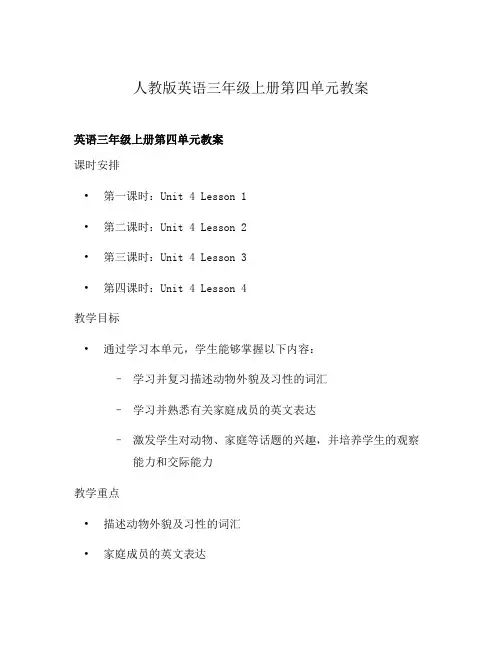
人教版英语三年级上册第四单元教案英语三年级上册第四单元教案课时安排•第一课时:Unit 4 Lesson 1•第二课时:Unit 4 Lesson 2•第三课时:Unit 4 Lesson 3•第四课时:Unit 4 Lesson 4教学目标•通过学习本单元,学生能够掌握以下内容:–学习并复习描述动物外貌及习性的词汇–学习并熟悉有关家庭成员的英文表达–激发学生对动物、家庭等话题的兴趣,并培养学生的观察能力和交际能力教学重点•描述动物外貌及习性的词汇•家庭成员的英文表达教学准备•教材:人教版英语三年级上册•外教或音频文件•PPT或课件教学过程第一课时:Unit 4 Lesson 1导入(5分钟)•利用图片或视频展示不同的动物,引导学生猜测动物的英文名称,并对比中文与英文的差异。
学习(15分钟)1.教师出示并教授动物的英文单词,要求学生模仿发音,并进行跟读练习。
2.借助图片和简单的句子,向学生介绍并讨论动物的外貌和习性。
操练(15分钟)1.老师出示动物图片,学生们以小组为单位,描述动物的外貌和习性。
2.教师适时给予指导和帮助,引导学生进行对话练习。
巩固(10分钟)1.分发练习册,完成有关动物外貌和习性的练习题。
2.学生交流和讨论答案,教师进行总结和点评。
第二课时:Unit 4 Lesson 2导入(5分钟)•通过图片展示和简单问答,引导学生回忆并复习上节课所学的动物词汇。
学习(15分钟)1.介绍并教授有关家庭成员的英文单词,要求学生模仿发音,并进行跟读练习。
2.借助图片和简单的句子,向学生介绍各种家庭成员。
操练(15分钟)1.老师出示家庭成员图片,学生们以小组为单位,互相介绍自己的家庭成员。
2.教师适时给予指导和帮助,引导学生进行对话练习。
巩固(10分钟)1.分发练习册,完成有关家庭成员的练习题。
2.学生交流和讨论答案,教师进行总结和点评。
第三课时:Unit 4 Lesson 3导入(5分钟)•利用图片或视频展示不同的动物,引导学生猜测动物的英文名称,并进行简单的问答交流。

Unit 4 We love animals单元整体分析本单元是义务教育人教版(pep)小学英语教科书三年级上册第四单元。
单元主题为We love animals (我们爱动物)。
主情景图通过孩子们上泥塑课时,讨论自己塑的小动物来引出本单元的重点话题:询问不认识的动物或事物并进行回答。
A部分共三页,分三课时。
第一课时为情景对话和练习部分。
Let’s talk部分中Wu Yifan和Mike在玩手影游戏,一个做,一个猜,引出本单元询问近处物品的问答句:What’s this? It’s a... 以及三会单词:duck, dog, bear。
玩一玩部分中,学生需要发出声音或做动作来模仿一个动物,其他学生猜出动物名称。
第二课时为重点词汇和重点句型呈现,这次是Sarah在和她弟弟一起玩手影,通过他们的手影引出动物类三会词汇:pig, bear, cat, duck, dog, 以及重点答句:It’s a ... Let’s chant是个与动物相关的韵句。
学生通过韵句来操练本课时学习到的重点动物词汇。
第三课时为语音学习,通过听一听、读一读、唱一唱,听一听、圈一圈,听一听、写一写三个活动,学习字母JKLMM五个字母的字形、书写及其在单词里的发音。
B部分共四页,分两课时。
第一课时仍然呈现情景对话和练习。
在Let’s talk中,Mike和朋友去马戏团看演出,引出如何询问远处的事物的句式:What’s that? 以及表达自己喜好的句式:I like it. Let’s play是个游戏活动。
学生两人一组,其中一人将动物卡片放在背后,另外一人使用句式:What’s that? It’s a ... 来猜出动物。
第二课时以Zoom和Zip用望远镜观察动物园的场来呈现三会词汇:panda, tiger, elephant, monkey, bird, zoo, 以及重点句式:What’s that? It’s a ...并通过一个TPR动作反应活动Let’s do,来练习这些重点词汇。
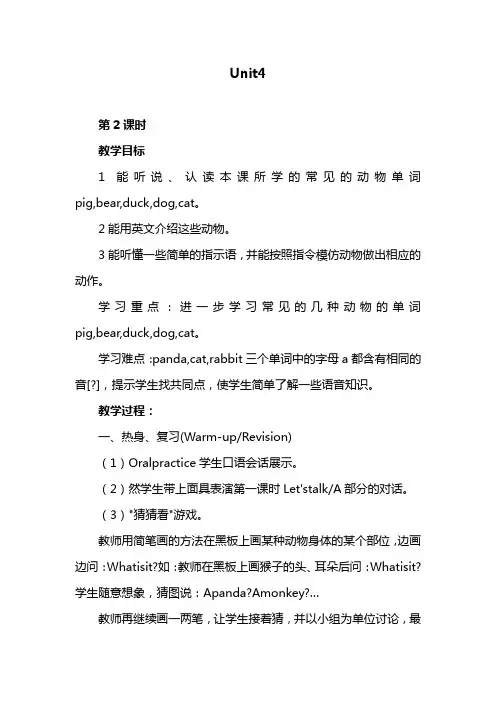
Unit4第2课时教学目标1能听说、认读本课所学的常见的动物单词pig,bear,duck,dog,cat。
2能用英文介绍这些动物。
3能听懂一些简单的指示语,并能按照指令模仿动物做出相应的动作。
学习重点:进一步学习常见的几种动物的单词pig,bear,duck,dog,cat。
学习难点:panda,cat,rabbit三个单词中的字母a都含有相同的音[?],提示学生找共同点,使学生简单了解一些语音知识。
教学过程:一、热身、复习(Warm-up/Revision)(1)Oralpractice学生口语会话展示。
(2)然学生带上面具表演第一课时Let'stalk/A部分的对话。
(3)"猜猜看"游戏。
教师用简笔画的方法在黑板上画某种动物身体的某个部位,边画边问:Whatisit?如:教师在黑板上画猴子的头、耳朵后问:Whatisit?学生随意想象,猜图说:Apanda?Amonkey?…教师再继续画一两笔,让学生接着猜,并以小组为单位讨论,最后由一名学生代表说出一个答案。
教师将图画完,带领学生一起说:Look!It'sa…猜对的小组赢得一分。
二、呈现新课(Presentation)(1)继续调动学生学习兴趣,接着刚才的游戏猜谜。
教师将所学的动物单词monkey,dog,duck,panda,cat,rabbit的图片提前贴在一块小黑板上,或提前贴在教室的黑板上,并在每幅动物图案上用纸张或其它物品遮盖好,只露动物的尾巴,让学生猜猜看Whatisit?,导入单词的学习。
(2)学生根据动物的尾巴猜谜,并七嘴八舌的讨论。
(3)教师将遮盖物取下,学生自然的发出感叹Wow!Great!随后教师请学生读单词。
(学生在第一课时已经初步学习了单词)此时教师不要急于纠正学生发音,而让学生相互说说、评评,让学生间相互纠正单词的发音。
(4)教师出示单词卡片,请学生将单词读出后将卡片贴在黑板上,并要求贴在相对应的图片底下。

【人教版】三年级上英语《Unit 4 》优质公开课教案一. 教材分析本课是人民教育出版社出版的三年级上册英语《Unit 4》的优质公开课教案。
本课主要围绕日常生活中的食物展开,通过学习本课,学生能够听懂、会说、会读关于食物单词和句子,并能够运用所学知识进行简单的日常交流。
二. 学情分析三年级的学生已经掌握了基本的英语语音、词汇和简单的句子结构,但对一些复杂的句子结构和词汇可能还不太理解。
因此,在教学过程中,需要注重学生对词汇、句子的理解和运用,同时激发学生的学习兴趣,提高他们的学习积极性。
三. 教学目标1.知识目标:学生能够听懂、会说、会读关于食物单词和句子,了解日常生活中的食物。
2.能力目标:学生能够运用所学知识进行简单的日常交流。
3.情感目标:培养学生热爱生活,关注健康的情感态度。
四. 教学重难点1.重点:学生能够听懂、会说、会读关于食物单词和句子。
2.难点:学生能够运用所学知识进行简单的日常交流,并能够正确运用一般现在时进行表达。
五. 教学方法采用情境教学法、互动教学法和任务型教学法,通过创设情境、学生互动、任务实践等方式,激发学生的学习兴趣,提高他们的学习积极性。
六. 教学准备1.教具准备:食物图片、食物卡片、录音机、磁带等。
2.教学环境:教室布置成餐厅情境,墙上贴上食物图片,桌子上摆放一些真实的食物。
七. 教学过程1.导入(5分钟)教师带领学生唱一首关于食物的英文歌曲,激发学生的学习兴趣。
然后向学生展示一些食物图片,引导学生用中文说出这些食物的名字。
2.呈现(10分钟)教师向学生展示食物卡片,并用英语介绍这些食物,让学生听懂并跟读。
同时,教师引导学生用中文翻译这些食物的名字。
3.操练(10分钟)教师学生进行小组活动,让学生互相用英语介绍自己喜欢吃的食物。
然后,教师选取一些学生介绍的食物,进行角色扮演,让学生在情境中运用所学知识。
4.巩固(10分钟)教师设计一个餐厅情境,让学生扮演服务员和顾客,用英语进行点餐和回答问题的练习。
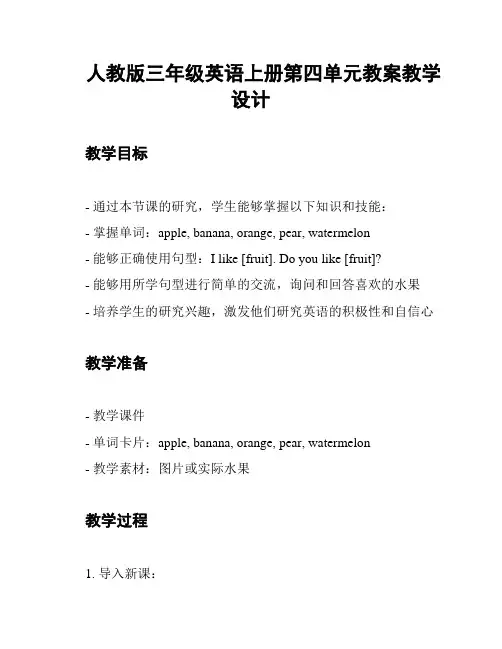
人教版三年级英语上册第四单元教案教学设计教学目标- 通过本节课的研究,学生能够掌握以下知识和技能:- 掌握单词:apple, banana, orange, pear, watermelon- 能够正确使用句型:I like [fruit]. Do you like [fruit]?- 能够用所学句型进行简单的交流,询问和回答喜欢的水果- 培养学生的研究兴趣,激发他们研究英语的积极性和自信心教学准备- 教学课件- 单词卡片:apple, banana, orange, pear, watermelon- 教学素材:图片或实际水果教学过程1. 导入新课:- 通过展示水果的图片或实际水果引起学生的兴趣。
- T: "What fruits do you know?" (教师将单词卡片分发给学生,学生逐个说出单词)- T: "Good job! Let's learn more about these fruits today."2. 研究新单词:- 教师通过课件展示单词和相关图片,引导学生跟读单词:apple, banana, orange, pear, watermelon- 教师和学生一起读单词几遍,确保学生能够正确发音和理解意思。
3. 研究新句型:- T: "I like apples. Do you like apples?" (教师展示第一句话,并带领学生一起读)- 教师通过示范和学生的模仿,逐句教授"Do you like [fruit]?"的句子。
- T: "Now, let's practice together. Ask your partner: Do you like apples?"4. 句型运用练:- 学生分为小组,进行两两对话练,使用新学的句型向对方询问和回答关于喜欢的水果。
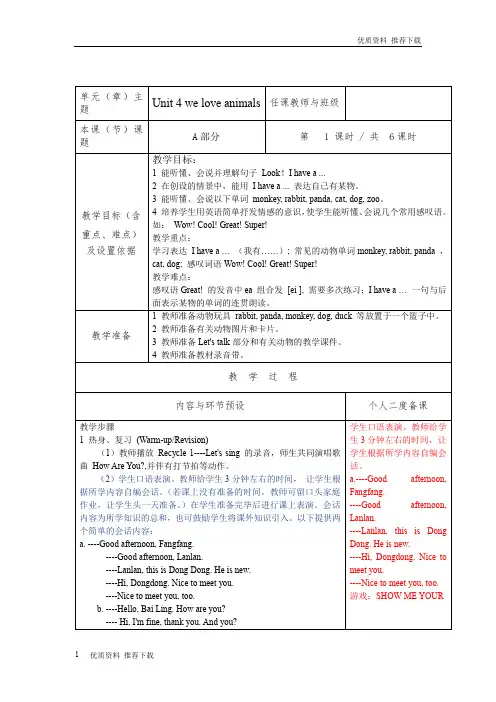
作业设计: 必做题:1.听录音,跟读P41的learn 和chant5遍; 2.边演边说Let ’s do 5遍; 补充题:你能把句子与表示动作的图片对应起来吗?1.Act like a rabbit .2.Act like a cat .3.Act like a panda .4.Act like a duck .1. Climb like a bear .作业设计:必做题:1.听录音,跟读P41的learn 和P40 Let’s talk 5遍;2.给课文写上中文意思;3.跟录音唱歌曲“Old MacDonald”选做题:课时特训P40:(4 5)作业设计: 必做题:1.听录音,跟读P41的learn 和P40 Let ’s talk 5遍; 2.边读边演P41的Let ’s do ;3.跟录音唱歌曲“Old MacDonald ” 选做题:课时特训P43: (6 7)作业设计:必做题:1.听录音,跟读P43 Let’s talk 5遍;2.跟录音唱歌曲“Old MacDonald”补充题:从B栏中找出A栏的答句,并将其字母代号填入相应的句子前的括号内。
A B( )1.May I have a look? A.Cool!( )2.Nice to meet you.B.Sure,here you are.( )3.Look! I have a monkey.C.Fine,thanks.( )4.It’s lovely.D.Nice to meet you,too.( )5.How are you? E.Thank you.作业设计:必做题:1.听录音,跟读P44 Let’s learn 5遍;2.跟说:Let’s do 5遍,边说边做。
选做题:课时特训: P44 (8 1 2)作业设计:必做题:1.听录音,跟读P45 Let’s chant 5遍;2.跟说:Let’s do 5遍,边说边做;3.跟录音唱P47 的歌曲“Hop, Brown Squirrel”;补充题:按动物的本领分类,把序号填在横线上1.cat 2.bird 3.rabbit 4.squirrel 5.monkey 6.duck 7.dog 8.fish Animals that can fly (能飞的):Animals that can jump (能跳的):Animals that can swim (能游的):。

Unit 4 Look at me!Part A 第一课时Let's talk &Let's play 教学目标:1.能听懂并会说句型:“What's this? It's a …”。
2.掌握有关动物名称的单词,如duck, dog, bear等。
3.培养学生的观察能力、模仿能力与口头表达能力。
4.教育学生要热爱动物,增强学生保护动物的意识。
教学重点:能灵活运用句型:“What's this? It's a …”来进行问答。
教学难点:单词this和it's的发音。
教学准备:教学实物(鸭子、小熊、小狗)、教学光盘。
教学过程:Step 1: Warm upFree talk:T: Good morning, boys and girls.Ss: Good morning, Miss Chen.T: How are you?S1: I'm fine, thank you.T: Nice to meet you.S1: Nice to meet you, too.Step 2: Presentation(1)教师展示一本书,并介绍It's a book.指着一支蜡笔,并说:It's a crayon.指着一支铅笔,并说:It's a pencil.教学生读句子It's a …并解释意思。
(2)教师出示一个鸭子实物,教师问:“What's this?”,引导学生用It's a …句型来作答,教师补充It's a duck.让同桌间互换角色进行问答,提示注意“this”“it's”发音。
(3)教师展示Zoom的图片,学生:It's Zoom. T: Yes, it's Zoom. It's a bear.解释bear并教读。
(4)利用多媒体课件放出小狗的声音,并让学生猜是什么。
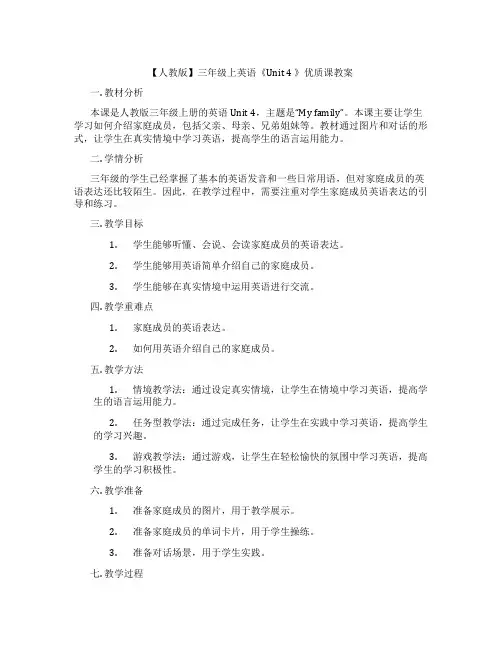
【人教版】三年级上英语《Unit 4 》优质课教案一. 教材分析本课是人教版三年级上册的英语Unit 4,主题是“My family”。
本课主要让学生学习如何介绍家庭成员,包括父亲、母亲、兄弟姐妹等。
教材通过图片和对话的形式,让学生在真实情境中学习英语,提高学生的语言运用能力。
二. 学情分析三年级的学生已经掌握了基本的英语发音和一些日常用语,但对家庭成员的英语表达还比较陌生。
因此,在教学过程中,需要注重对学生家庭成员英语表达的引导和练习。
三. 教学目标1.学生能够听懂、会说、会读家庭成员的英语表达。
2.学生能够用英语简单介绍自己的家庭成员。
3.学生能够在真实情境中运用英语进行交流。
四. 教学重难点1.家庭成员的英语表达。
2.如何用英语介绍自己的家庭成员。
五. 教学方法1.情境教学法:通过设定真实情境,让学生在情境中学习英语,提高学生的语言运用能力。
2.任务型教学法:通过完成任务,让学生在实践中学习英语,提高学生的学习兴趣。
3.游戏教学法:通过游戏,让学生在轻松愉快的氛围中学习英语,提高学生的学习积极性。
六. 教学准备1.准备家庭成员的图片,用于教学展示。
2.准备家庭成员的单词卡片,用于学生操练。
3.准备对话场景,用于学生实践。
七. 教学过程1.导入(5分钟)利用图片引入家庭成员的主题,让学生猜测图片中的人物是谁,激发学生的学习兴趣。
2.呈现(10分钟)展示家庭成员的单词卡片,让学生逐一读出单词,并在图片对应的家庭成员上贴上卡片。
通过这种方式,让学生熟悉家庭成员的英语表达。
3.操练(10分钟)让学生分成小组,用家庭成员的单词卡片进行角色扮演,模拟真实场景,练习用英语介绍家庭成员。
教师巡回指导,纠正发音并给予鼓励。
4.巩固(10分钟)让学生用英语介绍自己的家庭成员,其他学生倾听并纠正发音。
通过这种方式,巩固所学知识。
5.拓展(5分钟)让学生想象一下自己的家庭成员有什么特点,用英语进行描述。
通过这种方式,提高学生的语言运用能力。
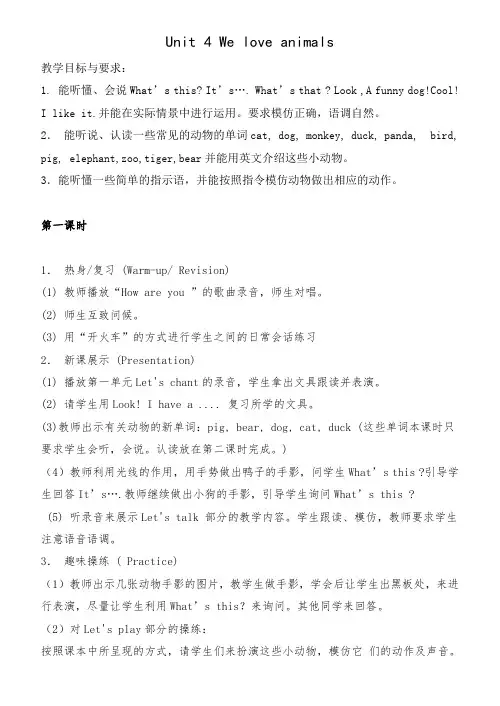
Unit 4 We love animals教学目标与要求:1. 能听懂、会说What’s this? It’s…. What’s that ? Look ,A funny dog!Cool!I like it.并能在实际情景中进行运用。
要求模仿正确,语调自然。
2.能听说、认读一些常见的动物的单词cat, dog, monkey, duck, panda, bird, pig, elephant,zoo,tiger,bear并能用英文介绍这些小动物。
3.能听懂一些简单的指示语,并能按照指令模仿动物做出相应的动作。
第一课时1.热身/复习 (Warm-up/ Revision)(1) 教师播放“How are you ”的歌曲录音,师生对唱。
(2) 师生互致问候。
(3) 用“开火车”的方式进行学生之间的日常会话练习2.新课展示 (Presentation)(1) 播放第一单元Let's chant的录音,学生拿出文具跟读并表演。
(2) 请学生用Look! I have a .... 复习所学的文具。
(3)教师出示有关动物的新单词:pig, bear, dog, cat, duck (这些单词本课时只要求学生会听,会说。
认读放在第二课时完成。
)(4)教师利用光线的作用,用手势做出鸭子的手影,问学生What’s this ?引导学生回答It’s….教师继续做出小狗的手影,引导学生询问What’s this ?(5) 听录音来展示Let's talk 部分的教学内容。
学生跟读、模仿,教师要求学生注意语音语调。
3.趣味操练 ( Practice)(1)教师出示几张动物手影的图片,教学生做手影,学会后让学生出黑板处,来进行表演,尽量让学生利用What’s this?来询问。
其他同学来回答。
(2)对Let's play部分的操练:按照课本中所呈现的方式,请学生们来扮演这些小动物,模仿它们的动作及声音。
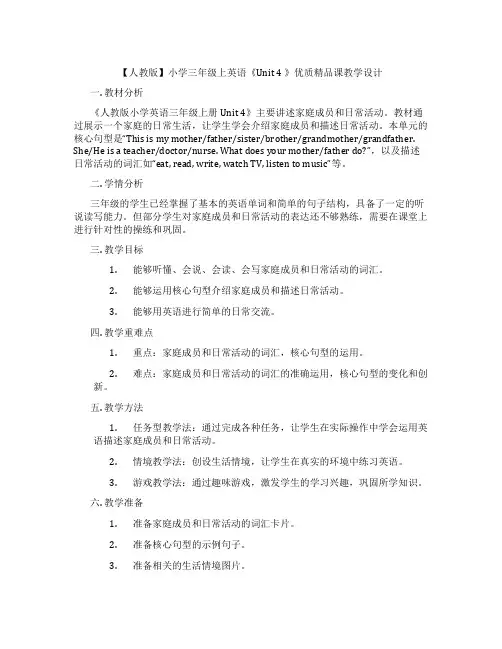
【人教版】小学三年级上英语《Unit 4 》优质精品课教学设计一. 教材分析《人教版小学英语三年级上册Unit 4》主要讲述家庭成员和日常活动。
教材通过展示一个家庭的日常生活,让学生学会介绍家庭成员和描述日常活动。
本单元的核心句型是“This is my mother/father/sister/brother/grandmother/grandfather. She/He is a teacher/doctor/nurse. What does your mother/father do?”,以及描述日常活动的词汇如“eat, read, write, watch TV, listen to music”等。
二. 学情分析三年级的学生已经掌握了基本的英语单词和简单的句子结构,具备了一定的听说读写能力。
但部分学生对家庭成员和日常活动的表达还不够熟练,需要在课堂上进行针对性的操练和巩固。
三. 教学目标1.能够听懂、会说、会读、会写家庭成员和日常活动的词汇。
2.能够运用核心句型介绍家庭成员和描述日常活动。
3.能够用英语进行简单的日常交流。
四. 教学重难点1.重点:家庭成员和日常活动的词汇,核心句型的运用。
2.难点:家庭成员和日常活动的词汇的准确运用,核心句型的变化和创新。
五. 教学方法1.任务型教学法:通过完成各种任务,让学生在实际操作中学会运用英语描述家庭成员和日常活动。
2.情境教学法:创设生活情境,让学生在真实的环境中练习英语。
3.游戏教学法:通过趣味游戏,激发学生的学习兴趣,巩固所学知识。
六. 教学准备1.准备家庭成员和日常活动的词汇卡片。
2.准备核心句型的示例句子。
3.准备相关的生活情境图片。
4.准备趣味游戏。
七. 教学过程1.导入(5分钟)利用图片展示一个家庭,引导学生谈论家庭成员。
询问学生:“Can you introduce your family members?”,让学生用中文回答,然后用英语进行翻译。

Unit4 We love animals单元备课教学目标:【知识目标】1.重点字母:Jj、Kk、Ll、Mm、Nn2.重点词汇:duck、pig、cat、bear、dog、elephant、monkey、bird、tiger、panda、zoo3.重点句型:—What's this?—It's a/an... —What's that?—It's a/an...【能力目标】1. 能够在图片、实物、情景中运用句型问答近处的物品。
2.能运用句型问答远处的物品。
3.能运用句子“Cool!I like it.”表达赞美。
【情感目标】培养学生热爱动物的情感。
教学重点:1.听、说、认读、写字母Jj~Nn,听、说、认读单词duck、pig、cat、bear、dog、zoo、bird、panda、tiger、elephant、monkey。
2.句型“—What's this?—It's a/an...”“—What's that?—It's a/an...”的运用。
教学难点:1.正确规范地书写字母。
2.熟练地运用句型问答近处的物品。
3.能在语境中区分和运用“What's this?”和“What's that?”。
教学准备:课本、人物头饰、不同颜色的蜡笔、字母卡片图、课件。
课时安排:6课时第 1 页共 14 页新人教版三年级上册英语Unit4单元教案第 2 页共 14 页第一课时一、教学内容:Part A Let’s talk & Let’s play二、教学目标1.能理解对话,能用正确的语音语调朗读对话,并能根据对话的情景进行对话角色表演。
2. 能够听说dog, duck, bear三种动物的名称。
3. 能在语境中运用What's this? It's a ... 来交流动物信息。
4. 了解英语中部分动物叫声的拟声词。
12必做题:1.听录音,跟读P41的learn 和chant5遍;2.边演边说Let’s do 5遍;补充题:你能把句子与表示动作的图片对应起来吗?2.Act like a cat.3.Act like a panda.4.Act like a duck.1.Climb like a bear.34必做题:1.听录音,跟读P41的learn 和P40 Let’s talk 5遍;2.给课文写上中文意思;3.跟录音唱歌曲“Old MacDonald”选做题:课时特训P40:(4 5)56作业设计:必做题:1.听录音,跟读P41的learn 和P40 Let’s talk 5遍;2.边读边演P41的Let’s do;3.跟录音唱歌曲“Old MacDonald”选做题:课时特训P43:(6 7)789作业设计:必做题:1.听录音,跟读P43 Let’s talk 5遍;2.跟录音唱歌曲“Old MacDonald”补充题:从B栏中找出A栏的答句,并将其字母代号填入相应的句子前的括号内。
A B( )1.May I have a look? A.Cool!( )2.Nice to meet you.B.Sure,here you are.( )3.Look! I have a monkey.C.Fine,thanks.( )4.It’s lovely.D.Nice to meet you,too.( )5.How are you? E.Thank you.10作业设计:必做题:1.听录音,跟读P44 Let’s learn 5遍;2.跟说:Let’s do 5遍,边说边做。
选做题:课时特训: P44 (8 1 2)作业设计:必做题:1.听录音,跟读P45 Let’s chant 5遍;2.跟说:Let’s do 5遍,边说边做;3.跟录音唱P47 的歌曲“Hop, Brown Squirrel”;补充题:按动物的本领分类,把序号填在横线上1.cat 2.bird 3.rabbit 4.squirrel 5.monkey 6.duck 7.dog 8.fish Animals that can fly (能飞的):Animals that can jump (能跳的):Animals that can swim (能游的):。
人教版小学英语三年级上册Unit4WeLoveAnimals!优秀教案一、教学目标1.让学生掌握本单元的核心词汇:tiger,lion,elephant,zebra,Hippo,monkey,panda。
2.让学生学会使用句型:“Ilike”和“Yes,Ido./No,Idon't.”进行动物喜好交流。
3.培养学生热爱动物、保护环境的意识。
二、教学重难点重点:掌握核心词汇和句型。
难点:运用所学句型进行实际交流。
三、教学准备1.课件或黑板2.图片卡片3.动物模型或玩具4.录音机或音响设备四、教学过程Step1:导入1.利用课件或黑板展示各种动物图片,引导学生说出动物名称。
2.邀请学生模仿动物叫声,活跃课堂氛围。
Step2:新课呈现1.利用课件展示本节课核心词汇,引导学生跟读并模仿发音。
2.带领学生学习句型“Ilike”和“Yes,Ido./No,Idon't.”,并进行实际操作。
3.展示动物图片,引导学生用所学句型进行交流。
Step3:活动环节1.分组讨论:每组选择一种动物,讨论该动物的特点及喜好。
2.角色扮演:学生两人一组,一人扮演动物,另一人扮演提问者,用所学句型进行交流。
3.游戏环节:设置“动物猜猜猜”游戏,学生根据提示猜出动物名称,答对者得分。
Step4:巩固环节1.复习核心词汇和句型,并进行问答练习。
2.学生自主选择一种动物,用所学句型介绍该动物。
Step5:课堂小结2.强调保护动物、热爱环境的重要性。
Step6:课后作业1.复习本节课所学内容,巩固核心词汇和句型。
2.家长协助孩子用所学句型介绍一种动物,并录制视频,下节课分享。
五、教学反思本节课通过多种教学手段,让学生在轻松愉快的氛围中掌握了核心词汇和句型。
在活动环节,学生积极参与,提高了实际交流能力。
但在课堂小结环节,时间安排不够合理,导致部分学生未能充分展示自己。
在今后的教学中,需注意时间分配,确保每个学生都有机会参与课堂活动。
三年级上册英语导学案-Unit 4 lesson2《pets》∣人教新起点一、课程目标1.能够认读并正确使用以下单词:cat, dog, fish, bird;2.能够使用“Has/Have”来描述别人拥有的宠物;3.能听懂老师或同学在描述宠物时所使用的句子;4.能够表达出自己对于宠物的喜好或者描述自己的宠物。
二、教学重点1.单词cat, dog, fish, bird的认读与正确使用;2.Has/Have句式在描述别人拥有宠物时的应用;3.能够听懂并理解句子:She has a cat. / He has a dog. / Does he havea fish? / Yes, he does. / No, he doesn’t.三、教学难点1.能够口语表达自己的喜好;2.能够参与到对话中,使用之前学过的语言和知识交流。
四、教学过程1. Warm-up针对上一课的内容:将学生分为小组,每组按照在课堂上所学的句子和单词来进行角色扮演,如模拟买糖果,买水果和玩具等。
2. Presentation1.学生听老师介绍宠物主人的照片,并根据照片内容猜测宠物主人拥有什么宠物,例如猫、狗、金鱼或鸟等。
2.学生对比结果,回答:She/He has a cat/dog/fish/bird.3. Practice小组活动: 1. 将学生分为四人小组,每人介绍自己的宠物和对宠物的喜好。
2. 两个小组交换学生进行角色扮演,设置场景如市场或宠物店。
3. 每个小组的一名成员担任客户,描述自己想要的宠物和各种要求(如颜色、品种等)。
4. 另外三名成员扮演店员,提供客户所需要的信息。
4. Consolidation1.将学生分成小组,进行模拟面试的练习,其中每个学生都有机会成为采访官、被采访者或摄影师。
2.学生扮演宠物展览的主持人,介绍各种不同的宠物,分享其中所知道的事情,并邀请同学分享对宠物的喜好。
5. Evaluation进行小测验或者课堂讨论,检测学生所掌握的词汇和语言表达水平。
三年级上册英语教案-Unit 4《Pets》(第2课时)|人教新起点教学目标1.学习宠物英文单词fish,rabbit,hamster,tortoise和mouse,了解它们的生活习性;2.能听懂并顺利表演谈论宠物话题的对话,并交流自己的宠物;3.培养学生的小组合作和交流能力,加深学生对宠物类动物的兴趣和爱护意识。
教学重难点1.教学重点:掌握新单词并掌握用英语谈论宠物话题;2.教学难点:对单词发音的正确掌握。
教学准备1.教师准备:PPT,教案,板书设计,课件;2.学生准备:学生课本,文具。
教学过程一、Warm-up1.Greetings;2.Show some pictures of pets to inspire enthusiasm for the topic;3.Ask students if they have pets and how they take care of them.二、New Words1.The teacher shows flashcards of the new words: fish,rabbit,hamster,tortoise和mouse;2.The teacher pronounces the words and the students repeat,simultaneously observing the pictures of the animals;3.The teacher leads the students to talk about the different living habits of each animal, and discuss how to take care of these pets.三、Listening1.The teacher plays the recording of a dialogue about pets;2.The students listen carefully and trace the dialogue clues ontheir books;3.The teacher asks the students if they have any problems, and then answers the questions;4.The teacher asks if they know any other pets but they are not shown in the dialogue.四、Pair Work and Group Work1.The teacher will group the students into pairs and ask them to ask each other about their pets;2.The teacher then asks each group to report on one thing that they learnt about their partner’s pet;3.The teacher will then form groups of four and provide them withone of the five pet toys received from their classmates;4.The teacher then asks each group to report on how they would take care of the pet based on its characteristics and needs.五、Summary1.The teacher sums up the key knowledge points and encourages students to pay more attention to the care of pets in their daily lives;2.The teacher will explain the correct pronunciation of the new words.六、Exercise1.The teacher will assign exercise questions (填空题) to students after class;2.Teachers can correct the answers in the next class.教学反思1.整节课的主题围绕宠物展开,使学生对生活中的宠物充满了热情;2.教师利用多媒体设备和合作学习,引导学生积极参与,从而增强学生的自主学习能力;3.教材中的新单词和对话与学生的实际生活紧密联系,使学生能够将学习到的知识运用到生活中去。
三年级上册英语教案 Unit4 第2课时∣人教新起点教学内容本节课是Unit 4《We Love Animals》的第2课时,继续围绕动物主题展开,主要学习内容为认识并描述不同的动物特征,如颜色、大小等,并能够用英语表达对动物的喜爱。
教学目标1. 学生能够听懂、会说、会读本节课所学的动物单词和描述动物的句子。
2. 学生能够运用所学单词和句型,描述自己喜欢的动物。
3. 培养学生对动物的热爱和保护意识。
教学难点1. 动物单词的发音和记忆。
2. 描述动物特征的句型构造。
3. 学生对动物特征的观察和描述能力。
教具学具准备1. 动物卡片。
2. 彩色图片。
3. 录音机及录音带。
4. 黑板和粉笔。
教学过程1. 复习导入:通过复习上一课时学过的动物单词,引入本课时的学习内容。
2. 新课展示:展示本节课要学习的动物图片,引导学生学习新的动物单词和描述动物的句子。
3. 小组活动:学生分组,每组选择一个动物,用英语描述该动物的特征,并表达对该动物的喜爱。
4. 课堂练习:通过听录音、看图片等方式,让学生练习本节课所学的内容。
5. 成果展示:每组学生向全班展示他们的学习成果,其他学生进行评价。
板书设计1. 动物单词列表。
2. 描述动物的句子结构。
3. 学生展示的评价标准。
作业设计1.抄写并默写本节课所学的动物单词。
2.用英语写一段话,描述自己喜欢的动物。
3.预习下一课时的内容。
课后反思本节课学生参与度高,学习氛围良好。
但在教学过程中,发现部分学生对动物单词的发音掌握不够准确,需要在今后的教学中加强语音训练。
另外,对于描述动物特征的句型,部分学生构造句子时存在困难,需要在课后进行个别辅导。
总体来说,本节课达到了预期的教学效果,但也需要在今后的教学中对存在的问题进行改进和提升。
教学难点是教学过程中的关键环节,它直接关系到学生对知识点的理解和掌握。
在本教案中,教学难点包括动物单词的发音和记忆、描述动物特征的句型构造、学生对动物特征的观察和描述能力。
Unit 4 We Love AnimalsPart A Let’s learnⅠ. Teaching Objectives1.Learn the words:pig, bear, cat, duck, dog. Enable the students to use these words well.2.Learn the pattern “What’s this? It’s a duck.” Enable the students to use the pattern well.3.Emotion aims: To love animals.Ⅱ. Teaching ImportancesWhat’s this? It’s a duck.Ⅲ. Teaching DifficultyWhat’s this? It’s a duck.Ⅳ. Teaching AidCAI, word cards, video,Ⅴ.Teaching Procedure:Step1.warm-up1) Sing a song: How are you?2) Let’s doStep2. PresentationT: It’s a nice day today. Let’s go to a farm. OK?1) Learn the word “pig”CAI shows a nice farm. There’s a pig on the farm. T: Look! What’s this? It’s a pig. Guide Ss to read one by one. T: In this word, i is prounced /i/. /i//i/, pig. Present the sentence: It’s a pig. Guide Ss to describe the pig like this: The pig is pink. The pig is big. Present : Look at the pig. It is big. Guide Ss to read and act.2) Learn the word “dog”.CAI shows a brown dog. T: The pig is pink. Is it pink? No, it’s brown. It’s a dog. Guide Ss to read one by one. In this word, i is prounced /ɔ/./ɔ//ɔ/,dog. Present the sentence: It’s a dog. Guide Ss to describe the dog like this: The dog is brown. The dog is small. T: Where is the dog? It’s on the log. Guide Ss to read the word “log”. /ɔ//ɔ/, dog. And the sentences “ Look at the dog. It’s on the log.”.3) Learn the word “cat”.T: The dog is on the log. What animal is on the log, too? It’s a cat. Guide Ss to read one by one. In this word, a is prounced /æ/. /æ/ /æ/cat. Present the sentence: It’s a cat. CAI shows some pictures about the cats. Guide Ss to describe them like this: The cat is white. The cat is black. The cat is brown. The cat is fat. Present the sentences “Look at the cat. It is fat.” Guide Ss to read and act.4) Learn the word “duck”.Review the words Ss have learned before: pig, dog, cat. Play a guessing game. Some animalpictures are hidden .T: Guess. What animal is it? Ss: …. Present the word “duck”. Guide Ss to read one by one. In this word, u is prounced /ʌ/. / ʌ/ / ʌ/ duck. Present the sentence: It’s a duck. Guide Ss to describe the duck like this: The duck is yellow. The duck is lovely. The duck is small. T: Where is the duck? It’s on the truck. / ʌ/ / ʌ/ truck. Present the sentence: Look at the duck. It’s in the truck. Guide Ss to read and act.5) Learn the word “bear”.T: The duck is small. But the bear is big. Present the word “bear”. Guide Ss to read one by one. In this word, ear is prounced /ɛr/. /ɛr//ɛr/ bear. Present the sentence: It’s a bear. T: Where is the bear? It’s on the pear. /ɛr//ɛr/ pear. Present the sentence: Look at the bear It’s on the pear. Guide Ss to read and act.Step 3.Practice1) Read the new words together and have the chant.2) CAI shows some hand shadows, guide Ss to guess: It’s a duck/dog/cat….3) Task: Animal ShowCAI shows some animals on the farm. There’s an animal show. T: It’s a duck. It’s yellow. It’s in the truck…5Ss a group, try to introduce animals on the farm. Every student acts one kind of animals.4)make a dialogue with your partnerWhat’s this? It’s a …Ⅵ. Homework1.listen to the tape and read follow it.2. Act out the dialogue with your classmates.Ⅶ.Blackboard DesignUnit4 We love animalsdog duck cat bear pigⅧ.Self-examinationUnit 4Part A Let’s talkⅠ. Teaching Objectives1.Learn the words:pig, bear, cat, duck, dog. Enable the students to use these words well.2.Learn the pattern “What’s this? It’s a duck.” Enable the students to use the pattern well.3.Emotion aims: To love animals.Ⅱ. Teaching ImportancesWhat’s this? It’s a duck.Ⅲ. Teaching DifficultyWhat’s this? It’s a duck.Ⅳ. Teaching AidCAI, word cards, video,Ⅴ.Teaching Procedure:Step 1 Warm-up1. Greetings. (Divide the students into 5 groups named pig, bear, cat, duck, dog)2. Sing a song:Hello. Hello, duck ,do oh do. Hello, dog, do oh do. T: Let’s sing the song: Hello.T: Can you sing the song again?( dog, duck and bear)Ss: Yes. (Sing the song together)T: dog, duck and bear are animals. This class we’ll learn a bout animals. Some animals are having a party. Let’s have a look. OK?Step 2 PresentationdogT: The first one is dog. Follow me: dog.T: Group dog. Read it.Read one by one.T: Let’s write. (dog)Read again.duckT: No 2. duck. Follow me.T: OK. Let’s wri te. Follow me again.T: Give you the card, read it one by one.bearT: Look, who comes? yes, bear. Follow me, bear.Ss: bear.T: Group bear, you please.T: Let’s write it.( bear)4. cat 、pigStep3 PracticeBomb gameT: Group dog, dog is the bomb. Let’s read.Ss: dog, duck, bear, cat, pig.What’s missing:T: Close your eyes. OK, open your eyes. What’s missing?Let’s guessT: Look at here. What’s this?S: It’s a dog/ duck/bear/ ca/pig.T: Look at here. I have a big bag. There are many animal toys in it. Please guess:What’s this? It’s a….Let’s chant.T: OK, let’s see: Where is the dog?———I t’s on the log.T: Follow me: look at the dog, it’s on the log.Ss: Look at the dog, it’s on the log.T: Look at this one. Who?Ss: duckT: Yes, Where is the duck? Oh, it’s in the …T: Who can try to read it?S: truck.T: Follow me: look at the duck, it’s in the truck.T: Look, what’s this? Ss: pear.T: Oh, yes, look at the bear, it’s on the pear. Follow me.T: look at the …Ss: catT: Yes, this word, read it.Look at the cat. It is fat. Try to read.T: This one …Ss: pigT: Look at the pig. It is big. Try to read.T: The animals are happy together. Let’s chant, ok? Ss: OK.Step4 SummaryT: Class, some animals come here, but some animals can’t come here. Let’s see them. T: All the animals are our friends. We should love animals. (love animals)T:Now stand up, show me your hands and follow me.Ⅵ. Homework1. listen to the tape and read follow it.2. Act out the dialogue with your classmates.3. Finish the workbook.Ⅶ. Blackboard DesignUnit4 We love animalsWhat’s this? dog duckIt’s a … cat bear pigⅧ.Self-examinationUnit4 Part B Let’s learnⅠ. Teaching Objectives1.Be able to listen,say and read the words: zoo, bird, panda, tiger, elephant, monkey2. Love animals.Ⅱ. Teaching ImportancesListen,say and read the words: zoo, bird, panda, tiger, elephant, monkeyⅢ. Teaching Difficulty1. Pronunciation of new words.2. Using of a/an in the sentences.Ⅳ. Teaching AidVideo, cards,Ⅴ.Teaching Procedure:Step1.warm-up1) Let’s chant (P39)2) CAI Shows the pictures of animals (pig, cat, duck, dog, bear)T: What’s that? S: It’s a … (T guides Ss to say: Oh, it’s big/ funny.)Step2. PresentationT: Look at the bear. It’s in the zoo.1)Lear n the word “zoo”(CAI shows the picture of Younger Zoo in Ningbo)Guide Ss learn the new word: /u:/. /u:/. ZooGuide Ss talk in pairs: What’s that? It’s a zoo.Guide Ss to say: Look at the zoo. It’s big. It’s a big zoo.T: It’s a big zoo. Let’s go to the zoo, OK?Chant and do: Zoo, zoo, zoo, go to the zoo.2) Learn the word “panda”.(CAI shows part of a panda)T: Look, It’s white and black. What’s that? Guess!Guide Ss to learn the new word: a / æ / / æ / pandaGuide Ss talk in pairs: What’s that? It’s a pa nda.Guide Ss to describe the panda in the CAI: Look at the panda. It’s fat. It’s a fat panda.T (shows a toy panda): Look, I have a panda. I like it. What about you?Guide Ss to say: I like it.3) Learn the word “monkey”.T (shows a part of a toy monkey in hand): Look, It’s funny. What is this?Guess!Guide Ss to read the word: m /m/ /m/ monkey.Guide Ss to describe the toy monkey: Look at the monkey. It’s funny. It’s afunny monkey.1.After teaching the pencil and crayon.(T gives the toy monkey to a student, let her/ him talks with another student by using the sentences. ) S1: Look, I have a monkey. S2: It’s funny. I like it.4) Learn the word “tiger”.(T acts like a tiger) T: Is it a monkey? What’s this?Guide Ss to read the word: /ai/ /ai/ tiger (CAI shows some pictures of tigers.)Look at the tiger. It’s a cool tiger./ It’s a funny tiger. /It’s a big tiger.5) Learn the word “elephant”.(CAI shows a part of a big elephant) T: Look, it’s very big. Is it a pig?Guide Ss to read the word: e /e/ /e/ elephant.Guide Ss to say in pairs: What’s that? It’s an elephant. (Pay attention to “an”)T: I can act like an elephant. Let’s act like an elephant.Guide Ss to act and say: Act like an elephant.6) Learn the word “bird”.T: Act like a monkey. Act like a tiger. Act like a panda. Act like a bird.(T makes a hand shadow of a bird to help Ss to understand the word bird.)Guide Ss to read the word: b /b/ /b/ birdGuide Ss talk in pairs (边做手影): What’s this? It’s a bird.Guide Ss to talk about the birds in CAI: Look at the bird. It’s black/blue/white. I like it. Step3. Consolidation1) Let’s doLet Ss listen to the tape and do after it.2)Game: What’s missing?(CAI)T: Look at the zoo. I see many animals. What are they?Guide Ss to say out together and then ask Ss to close eyes.Guide S to find out which animal is missing.3) Game: Find out the changes(Word cards)To read the words on the blackboard together and then ask Ss to close eyes.T changes the places of two word cardsGuide S to find out the cards which are changed and read the words loudly.4) Let’s check (P44)Listen to the tape and do the exercise and then check the answers.Look and matchⅥ. Homework1. Read the words three times.2. Listen to tape five timesⅧ.Self-examinationUnit 4Part B Let’s talkⅠ. Teaching Objectives1. Be able to read and say the sentences: What’s that? It’s a tiger.2. Be able to know the orders: “Act like…”3. Love animals.Ⅱ. Teaching ImportancesSentence structures: What’s that? It’s a tiger. I like it.Ⅲ. Teaching Difficulty1. The differences between “this” and “that”.2. Using of a/an in the sentences.Ⅳ. Teaching AidVideo, cards, crayonsⅤ.Teaching Procedure:Step1.warm-up1. Sing a song: Old MacDonald2. Free talk.3. Have a match. Do as I say. If you can do it quickly, you can get a prize. Ready?T: Act like a cat. …Step 2 presentation and practiceShow some pictures about animals.T: What’s this?Ss: It’s a…Put some pictures away from the desk.T: What’s that?Ss: It’s a …Listen and guess what that is in MacDonald’s farm.Pair works. Ask and answer the pictures about MacDonald’s farm.S1: what’s that?S2: It’s a dog. Wolf, wolf, wolf.…Have a match.Look at the pictures on the BB. Now, please listen to me and run to the BB quickly. Hit it quickly as you can.Let’s have a chant.What’s this? It’s a dog, dog, dog!What’s that? It’s a cat, cat, cat!What’s this? It’s a …Step3. consolidationLet’s play.Take out your animal friends or your school things, or your toys, or your pictures…or something else. Can you make a dialogue with your partner?Show time.3. Sum up.Ⅵ. Homework1. Listen and read follow the tape.2. Finish the work book.Ⅶ. Blackboard DesignⅧⅠ1.2.3.4.Ⅱ. Teaching ImportancesListening Part B Let’s checkⅢ. Teaching DifficultyComprehend the meaning of the story.Ⅳ. Teaching AidVideo, cards, PPTⅤ.Teaching Procedure:Step 1 Warmming-up1Greeting2Sing a song “Old MacDonald”3Play game “I act you guess”T:What’s that?S:It’s a dog.Step 2 Presentation & Practice.1T:Some students are very happy .The animals are happy ,too. They are having a Party in a zoo now,Do you want to go to the zoo?S:Yes.( teach the word “zoo”)2watch a video about : Let’s learn.T:What’s that?Ss:...( tiger).tiger,tiger,ao,ao,ao . say and act.3teach other words: monkey、panda、elephant、bird。
作业设计: 必做题:
1.听录音,跟读P41的learn 和chant5遍; 2.边演边说Let ’s do 5遍; 补充题:
你能把句子与表示动作的图片对应起来吗?
1.Act like a rabbit .
2.Act like a cat .
3.Act like a panda .
4.Act like a duck .
1. Climb like a bear .
作业设计:
必做题:
1.听录音,跟读P41的learn 和P40 Let’s talk 5遍;2.给课文写上中文意思;
3.跟录音唱歌曲“Old MacDonald”
选做题:
课时特训P40:(4 5)
作业设计:
必做题:
1.听录音,跟读P41的learn 和P40 Let ’s talk 5遍; 2.边读边演P41的Let ’s do ;
3
.跟录音唱歌曲“Old MacDonald ” 选做题:
课时特训P43: (6 7)
作业设计:
必做题:
1.听录音,跟读P43 Let’s talk 5遍;
2.跟录音唱歌曲“Old MacDonald”
补充题:
从B栏中找出A栏的答句,并将其字母代号填入相应的句子前的括号内。
A B
( )1.May I have a look? A.Cool!
( )2.Nice to meet you.B.Sure,here you are.
( )3.Look! I have a monkey.C.Fine,thanks.
( )4.It’s lovely.D.Nice to meet you,too.( )5.How are you? E.Thank you.
作业设计:
必做题:
1.听录音,跟读P44 Let’s learn 5遍;2.跟说:Let’s do 5遍,边说边做。
选做题:
课时特训: P44 (8 1 2)
作业设计:
必做题:
1.听录音,跟读P45 Let’s chant 5遍;
2.跟说:Let’s do 5遍,边说边做;
3.跟录音唱P47 的歌曲“Hop, Brown Squirrel”;
补充题:
按动物的本领分类,把序号填在横线上
1.cat 2.bird 3.rabbit 4.squirrel 5.monkey 6.duck 7.dog 8.fish Animals that can fly (能飞的):
Animals that can jump (能跳的):
Animals that can swim (能游的):。